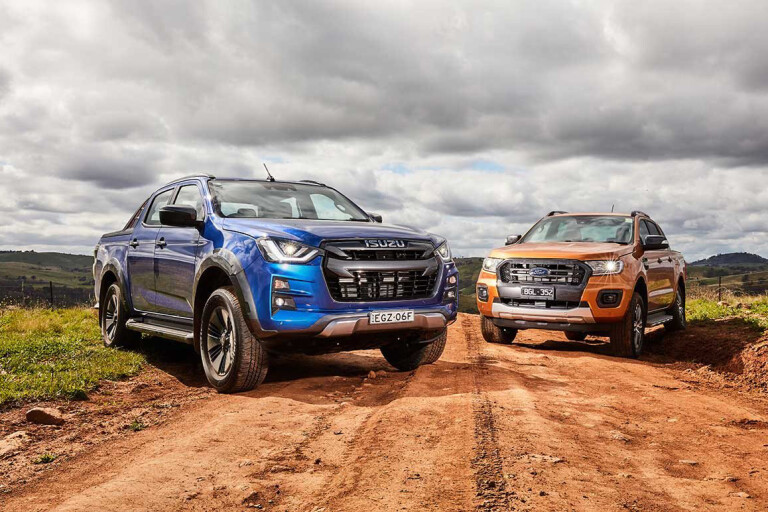
Utes and vans have overtaken passenger cars in overall sales for the first time in Australia.
The latest official industry figures have revealed the Light Commercial segment accounted for 60,066 vehicle sales in the first quarter of 2021, compared with 59,144 units for the Passenger Car category.
Light-commercial vehicles (LCVs) outsold passenger cars for six out of 12 months in 2020, as well as February 2021, but it took a repeat in March for utes and vans to take the lead in year-to-date figures for the first time ever.
LCVs have grown 26 per cent year to date, compared with a 19 per cent increase for SUVs and a nine per cent decrease for the segment that comprises hatchbacks, sedans, wagons, people-movers and sports cars.
The result is not unexpected as passenger-car sales have been in decline for more than a decade. They dropped below half a million units in 2016 then more than halved between 2017 – the year they were overtaken by SUV sales – and 2020.
.jpg )
A consumer exodus to SUVs has done the most damage to passenger-car sales, though utes – particularly dual-cab variants – have significantly increased in popularity with Australian families owing to their versatility.
Businesses have also been able to take advantage of the government’s generous instant-asset write-off incentives introduced in recent years.
Light-commercial vehicle sales surpassed 200,000 for the first time in 2016, coinciding with the Australian government’s first, $20,000 instant-asset policy. The asset(s) amount has since increased, up to as much as $150,000 for vehicles that have a payload capacity exceeding one tonne.
The gap between annual passenger car and LCV sales has plummeted from 316,613 sales in 2015 to just 16,506 in 2020.
Toyota’s HiLux has been Australia’s most popular vehicle for the past five years and is a clear favourite to make it six on the trot in 2021.
The Ford Ranger has installed itself as the country’s second best-selling vehicle, while the Mitsubishi Triton and Isuzu D-Max are regulars in the monthly Top 10 charts.
The lifestyle-focused 4x4 utes continue to work hardest for the Light Commercial segment and are up 23 per cent year on year to 45,036. Yet workhorse-focused 4x2 ute sales have also increased markedly – by 17 per cent to 7261 units so far in 2021.

And big vans (2.5-3.5 tonnes) are also shifting out of showrooms in bigger numbers – up 75 per cent (or 2823 vehicles) to 6598 units compared with the first quarter of 2020.
Light buses with up to 20 seats are also up by 10 per cent (692 vehicles), though 20-plus-seater versions are down 50 per cent and vans under 2.5 tonnes are down eight per cent.
Almost every 4x4 ute is registering growth of varying strength so far this year. The HiLux’s 40 per cent growth (and 46 per cent for its 4x2s) is remarkable for what is already the nation’s biggest seller, yet there many other stand-out figures.
They include the SsangYong Musso (up 184 per cent), LDV T60 (up 113 per cent), Mazda BT-50 (up 103 per cent), Isuzu D-Max (up 81 per cent) and Toyota LandCruiser 70-series (up 63 per cent).
Ford Australia will almost feel the Ranger is missing out with its nine per cent increase, though it has the biggest growth (65 per cent) in the 4x2 segment and overall remains the No.2 ute in sales by a considerable margin.
In the 2.5-3.5T Vans segment, the new-generation Toyota HiAce leads the way – up 80 per cent year to date to 2384 vehicles and 36 per cent market share.
Hyundai’s iLoad is next with 1159 sales, up 58 per cent, with the Ford Transit Custom third (884 sales, up 75 per cent).
Peugeot’s Partner is up 96 per cent, while fellow French van the Renault Trafic is up 79 per cent to be fourth most popular big van.
Chinese brand LDV continues to shine, with notable increases for both its G10 and V80 vans - up 109 and 45 per cent, respectively.
Vehicle segments: First quarter 2021
- SUVs – 135,900 (+19%)
- Light Commercial – 60,066 (+26%)
- Passenger Cars – 59,144 (-9%)
- Total Market – 263,648 (+13%)
Passenger Cars v LCVs since 2015: The ever-shrinking gap
| Year | Passenger cars | LCVs | gap |
| 2020 | 222,103 | 205,597 | 16,506 |
| 2019 | 315,875 | 225,635 | 90,240 |
| 2018 | 378,413 | 237,972 | 140,441 |
| 2017 | 450,012 | 236,609 | 213,403 |
| 2016 | 486,257 | 217,890 | 268,367 |
| 2015 | 515,683 | 199,070 | 316,613 |
COMMENTS